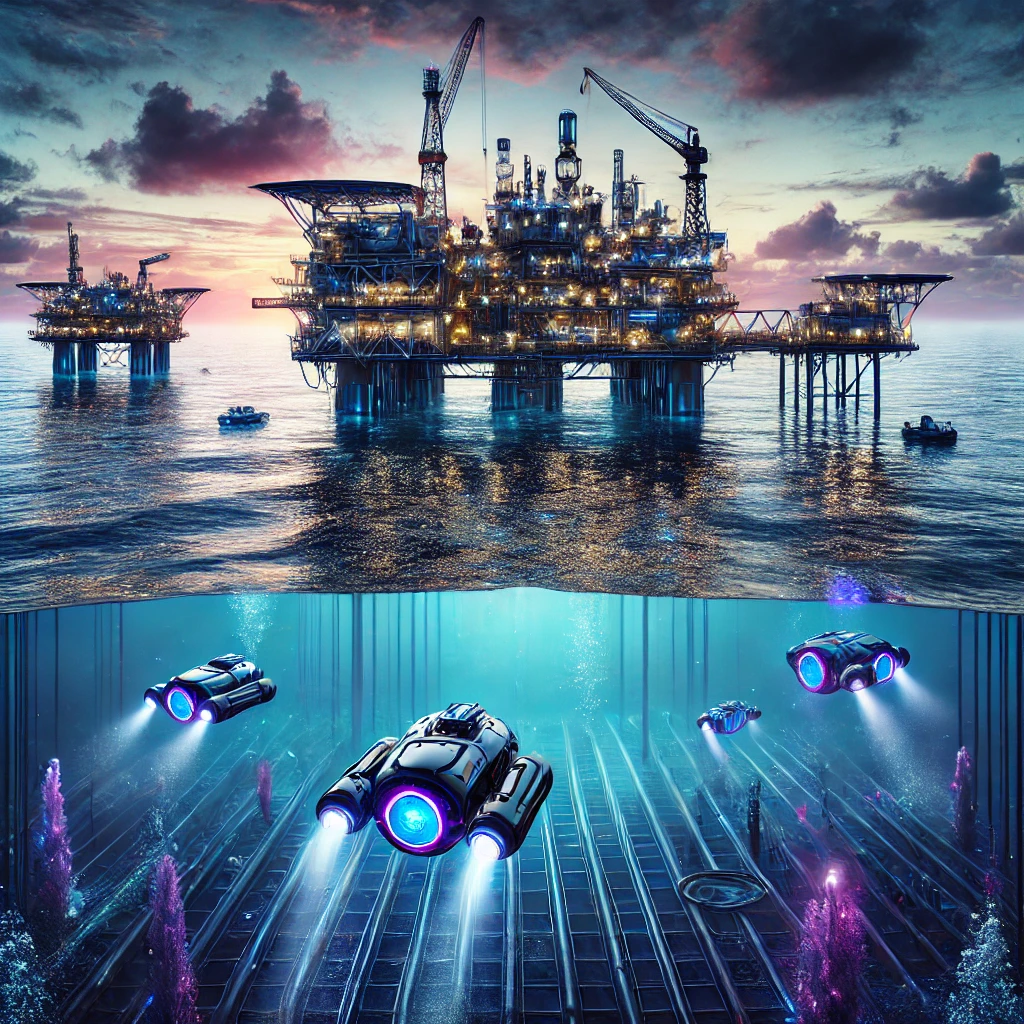During several decades, the energy sector began offshore drilling operations because people required more oil and gas supplies. The oil industry is now searching deep under the sea for new oil reserves since shallower resources have been depleted. Modern technology lets energy companies access marine resources from ocean depths at 500 meters.
Petroleum operations get assistance from the latest technology advances to perform deep offshore exploration. People should learn about these intricate platforms because business professionals and wider community members require a deeper understanding of resource access challenges in offshore areas.
What is Deep Offshore Technology?
Special tools and technology help companies access petroleum resources buried deep under water and many pounds of water pressure. Deep offshore technology manages all petroleum reservoir operations that lie between 500 meters deep to 2,000 meters undersea.
Companies need advanced engineering tools to survive extreme deep-water oil drilling conditions of freezing temperature and turbulent weather conditions. Deep offshore technologies include:
- Deepwater drilling facilities and platforms work without issues across any ocean conditions.
- If oil and gas extraction needs pipelines operating under 2,000 meters deep bottom water, it falls under subsea production.
- Dynamic positioning equipment keeps rigs and vessels steady in their selected positions.
- Remote-controlled underwater vehicles for inspections and maintenance.
- Modern seismic techniques let experts see the position and size of underground oil containers through the water surface.
- New technology tools find deepwater oil and gas resources since global energy demand keeps rising.
The Importance of Deep Offshore Technology in the Energy Sector
Meeting Growing Global Energy Demands
As world populations rise and manufacturing grows, people require extra energy supplies. The energy delivery sector must explore ocean depths for additional sources since worldwide energy consumption keeps rising. Deep offshore networks enable energy firms to recover natural resources from locations that cannot be reached due to their great depths of oil and natural gas production.
Energy companies seek their final substantial oil reserves deep under the waters of the Gulf of Mexico, Brazil, and West African seas.
Deep reservoirs give better energy supply value because the natural water resources close to the surface are running out quickly. Our society relies on the latest technology to locate and bring up hydrocarbon materials hidden within the earth.
Organizations that produce energy need deep offshore technology systems to supply worldwide energy needs. Current technology helps companies locate and remove oil and gas supplies to ensure worldwide access to energy resources.
Advancements in Drilling and Extraction Technologies
Underwater resource extraction needs special operating skills from the workers involved. A series of technological advancements over multiple years has created better deep offshore solutions for daily production problems. Some key developments include:
- Modern deepwater drilling rigs use dynamic positioning technology which makes them remain still despite water and sea movements. The industry discovered experimental rigs reached depths below 3000 meters despite scientific predictions against it.
- Deploying extraction tools beneath ocean floor waters saves money due to cheaper operations than installing more surface-based platforms. Undersea wells draw hydrocarbons through pipelines connected to manifold systems that transfer oil to ships before distribution at platforms.
- The basic safety tool, Blowout Preventers (BOP), shields against oil or gas leaks that happen beyond human control. After the BP Deepwater Horizon disaster, specialists placed electronic BOP systems at depth to prevent major accidents.
- Without support, AUVs inspect underwater operational tools for performance status and then perform needed maintenance. These tools function at deep underwater levels to obtain data and fix systems promptly without inducing long operational halts.
Environmental Considerations and Sustainability
The energy industry demands offshore drilling equipment to generate power while their systems automatically create environmental problems. Any pollution arising from petroleum oil creates significant damage to marine ecosystems directly and their associated surrounding environments. Several new protective systems have been included with deep offshore technology to ensure safety and environmental protection.
- Real-time oil field monitoring systems with automated valve systems reduce the damage done to operations while stopping petroleum leaks. Nearshore deepwater drilling works help protect the environment from hazards during operation.
- Seismic imaging equipment finds drilling site properties and environmental data beforehand during the operations preparation phase. Examining environmental conditions beforehand decreases the chances of damaging life below the sea.
- Carbon capture and storage (CCS) enables the industry to protect Earth by locking up carbon dioxide emissions from deep offshore drilling to place them permanently in underground rock formations.
- Petroleum exploration of deepwater areas uses environment-friendly methods that prevent major ecological harm.
The Future of Deep Offshore Technology
Autonomous Operations and Robotics
Robots will handle most deep offshore operations of the future alone. The harsh environmental conditions at extreme depths make human personnel unneeded for these job requirements. People today stay safe while working deep sea operations because robots and automated systems work hand-in-hand with drones to make platforms better.
Offshore systems work better under real-time conditions due to the help of Artificial Intelligence and Machine Learning systems that track maintenance needs. This enables us to set up preventive measures before equipment breakdowns happen and keep operations running.
Robotic sensors and control systems perform maintenance review tasks through their remote control functions even in underwater work locations. The system carries out intricate tasks automatically to save both spending and working time.
Floating LNG (FLNG) Technology
FLNG technology uses modern ways to extract natural gas at offshore platforms while keeping up with the latest industry standards. Natural gas liquefaction systems on floating platforms reduce costs by letting companies dispense with expensive underwater pipelines to move products to land.
FLNG technology gives companies the means to harvest natural gas from unserved regions since they lie too distant from major city pipelines. This technology benefits the environment because it requires no structures to be set up near coastal areas.
FLNG technology providers intend to enter global markets with undeveloped natural gas reserves at present. FLNG technology establishes a connection between traditional natural gas extraction and global demand for renewable power sources by deploying its advanced technology.
Digital Twin Technology in Deep Offshore
Companies rely on digital twin platforms to show offshore platforms online so they can boost their deep offshore operational practices. By creating exact duplicate operating spaces, engineers can test system functions against real-life conditions and find system faults to make system improvements.
Digital twins show operators what maintenance will be needed, allowing them to solve problems before machine failures happen.
Digital twins give business owners better ways to operate their company to deliver enhanced services that optimize oil extraction output.
Conclusion: The Transformative Impact of Deep Offshore Technology
Deep offshore technology brings transformative changes to the entire energy sector throughout exploration and extraction processes on ocean floors. Modern technology makes drilling more effective now and promotes eco-friendly systems to create sufficient energy supplies for worldwide markets.
Floating LNG technology will improve deep offshore technology by using robotic systems and artificial intelligence systems. Modern advancements in energy enable companies to create effective customer pathways to worldwide markets alongside clean power production.
FAQ
What is deep offshore technology?
Oil and gas businesses depend on unique technologies to access oil fields located beyond depths of 500 meters under the ocean surface.
How does deep offshore technology help companies improve their energy operations?
Deep offshore technology helps companies improve their energy operations by making them more effective. The ability to excavate energy resources from ocean floors enables energy companies to serve more clients because ocean-floor supplies will disappear soon.
What security measures must deep offshore drilling workspaces adhere to?
The safety setup includes sophisticated valves and controls to detect explosions, plus built-in security systems that lower the risks of big oil spills.
How well does artificial intelligence enhance deep offshore engineering technology performance?
Deep offshore technology now handles programmed maintenance and runs operations more effectively thanks to its combined artificial intelligence systems which instantly determine and correct outage problems and protect safety.
What is the technology behind Floating LNG (FLNG)?
An offshore FLNG platform processes natural gas in deep seas and ships it to other gas extraction areas in liquid form through marine vessels.





